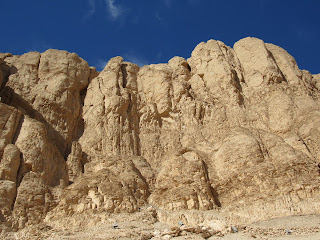Khan Al Khalili market
On our last full day in Egypt (a Saturday) we flew from Luxor back to Cairo:
Thank you, but by that point we'd already been in the country for nine days:
Passing by a mosque...:
...and a church on the drive into town from the airport:
We also drove by Ramses Train Station (1892), which we'd used to travel to and from Alexandria:
Crossing the Nile into Zamalek:
We met up with our friend Doering, and the four of us traveled by Uber to Cairo's massive Khan Al Khalili market, described by Lonely Planet as "basically a medieval-style mall":
Market activities have been taking place here since the 14th century and many Cairenes shop in the khan for daily sundries. However, the market also attracts a great many foreign visitors, and stalls selling the usual tourist tat are abundant:
So much for the stereotype of a strictly conservative Islamic society:
For dinner, we tried to bribe our away into Mahfouz in order to avoid the two-hour wait, but our efforts were unsuccessful. However, the nearby place selling feteers proved to be a delicious alternative:
Shu-E with Doering:
Doering was a most gracious hostess, putting us up at her place for our last night in town. Her three cats were pleased with the extra attention:
The Nile on a Saturday night...:
...and on a Sunday morning:
Google Maps said there was a Dunkin Donuts nearby, so Amber and I went out on Sunday morning in search of it. En route we passed by this less-than-politically correct Chinese place. Wok like an Egyptian?:
Where Dunkin Donuts should've been, there was only a wall. However, there turned out to be a McDonald's further along, so the two of us indulged in those morning treats that can't be enjoyed in Addis Ababa. More scenery along the way:
Sunday morning was spent in a fruitless search for a shop selling an official Egyptian national soccer team jersey (or even that of one of Cairo's major Egyptian Premier League clubs), but at least we did get to see some more of the city (and my wife satisfied her craving for fried chicken, going so far as to pick up some extra pieces from a KFC to bring back with her to Ethiopia!):
In the early afternoon, I walked over to the Cairo Marriott Hotel, which was once a palace for Empress Eugenie built by Khedive Ismail when the former visited for the opening of the Suez Canal in 1869:
While the interior is worth having a look around, the real reason for going there was to meet up with an A-100 classmate, Chandni, who by coincidence also happened to be in Cairo at the same time as us. One of the perks of this line of work is getting to see familiar faces in different parts of the world:
I walked around the neighborhood for a few more photo ops before our early evening ride to the airport, followed by our late night flight back to Addis Ababa. It would around 0400 hours local time on a Monday morning when we arrived home. Fortunately, I had arranged to take Monday off from work, and as Tuesday was the Orthodox Christmas Day, I was able to return to the office on Wednesday fairly well-rested:
Of course there were downsides. The hard sell from touts and vendors got tiring very quickly, and the traffic in Cairo (and Alexandria) at normal times is even worse than during peak hours here in Addis. And there are a lot of security restrictions that come with living and working in Cairo that I was able to avoid as a visitor. But the history of the country (and the sights that are a result) are incomparable and definitely worth seeing, and the people in general are welcoming to visitors from abroad. Tourism has been down since the 2011 revolution (and also due to some terrorist-related incidents in subsequent years), but we certainly didn't have any trouble on our trip. Go, I say!
Just be sure to have a lot of small bills handy for all the baksheesh you'll be distributing while you're there...






























































































































